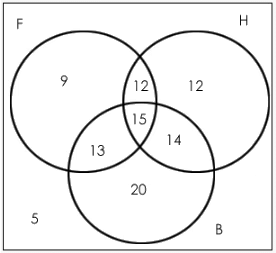Concept & Solved Questions: Venn Diagram | General Test Preparation for CUET UG - CUET Commerce PDF Download
| Table of contents |

|
| What is a Venn Diagram? |

|
| Formulas |

|
| Venn Diagram in case of two elements |

|
| Venn Diagram in case of three elements |

|
| Solved Examples: |

|
| Key Learnings |

|
What is a Venn Diagram?
Venn diagram, also known as an Euler-Venn diagram, is a simple representation of sets by diagrams. The usual depiction makes use of a rectangle as the universal set and circles for the sets under consideration.Venn diagrams are essential tools for the CUET UG exam's Logical Reasoning section. They simplify complex problems and are applicable across various topics like set theory and probability.
Formulas
n ( A ∪ B) = n (A) + n (B) - n (A ∩ B)
Venn Diagram in case of two elements

Venn Diagram in case of three elements

 |
Download the notes
Concept & Solved Questions: Venn Diagram
|
Download as PDF |
Solved Examples:
Example 1: In a college, 200 students are randomly selected. 140 like tea, 120 like coffee, and 80 like both tea and coffee.
Q1. How many students like only tea?
Q2. How many students like only coffee?
Q3. How many students like neither tea nor coffee?
Q4. How many students like only one of tea or coffee?
Q5. How many students like at least one of the beverages?
Solution: The given information may be represented by the following Venn diagram, where T = tea and C = coffee.
 • Number of students who like only tea = 60
• Number of students who like only tea = 60
• Number of students who like only coffee = 40
• Number of students who like neither tea nor coffee = 20
• Number of students who like only one of tea or coffee = 60 + 40 = 100
• Number of students who like at least one of tea or coffee = n (only Tea) + n (only coffee) + n (both Tea & coffee) = 60 + 40 + 80 = 180
Example 2: In a survey of 500 students at a college, it was found that 49% liked watching football, 53% liked watching hockey, and 62% liked watching basketball. Also, 27% liked watching football and hockey both, 29% liked watching basketball and hockey both, and 28% liked watching football and basketball both. 5% liked watching none of these games.
Q1. How many students like watching all three games?
Q2. Find the ratio of the number of students who like watching only football to those who like watching only hockey.
Q3. Find the number of students who like watching only one of the three given games.
Q4. Find the number of students who like watching at least two of the given games.
Solution:
n(F) = percentage of students who like watching football = 49%
n(H) = percentage of students who like watching hockey = 53%
n(B) = percentage of students who like watching basketball = 62%
Since 5% like watching none of the given games, so n (F ∪ H ∪ B) = 95%.
Now applying the basic formula,
95% = 49% + 53% + 62% -27% - 29% - 28% + n (F ∩ H ∩ B)
Solving, you get n (F ∩ H ∩ B) = 15%.
Now, make the Venn diagram as per the information given.
Note: All values in the given Venn diagram are in percentage.

Number of students who like watching all three games = 15% of 500 = 75.
Ratio of the number of students who like only football to those who like only hockey = (9% of 500)/(12% of 500) = 9/12 = 3:4.
The number of students who like watching only one of the three given games = (9% + 12% + 20%) of 500 = 205
The number of students who like watching at least two of the given games = (number of students who like watching only two of the games) + (number of students who like watching all three games) = (12 + 13 + 14 + 15)%, i.e., 54% of 500 = 270.
Example 3:
Directions for the question: Read the information given below and answer the question that follows.
Applicants for the doctoral programmes of Ambi Institute of Engineering (AIE) and Bambi Institute of Engineering (BIE) have to appear for a Common Entrance Test (CET). The test has three sections: Physics (P), Chemistry (C), and Maths (M). Among those appearing for CET, those at or above the 80th percentile in at least two sections and at or above the 90th percentile overall, are selected for Advanced Entrance Test (AET) conducted by AIE. AET is used by AIE for final selection. For the 200 candidates who are at or above the 90th percentile overall based on CET, the following are known about their performance in CET:
1. No one is below the 80th percentile in all 3 sections.
2. 150 are at or above the 80th percentile in exactly two sections.
3. The number of candidates at or above the 80th percentile in P is the same as the number of candidates at or above the 80th percentile only in C. The same is the number of candidates at or above the 80th percentile only in M.
4. Number of candidates below 80th percentile in P: Number of candidates below 80th percentile in C: Number of candidates below 80th percentile in M = 4:2:1.
BIE uses a different process for selection. If any candidate is appearing in the AET by AIE, BIE considers their AET score for final selection provided the candidate is at or above the 80th percentile in P. Any other candidate at or above the 80th percentile in P in CET, but who is not eligible for the AET, is required to appear in a separate test to be conducted by BIE for being considered for final selection. Altogether, there are 400 candidates this year who are at or above the 80th percentile in P.
 Question 1: What best can be concluded about the number of candidates sitting for the separate test for BIE who were at or above the 90th percentile overall in CET?
Question 1: What best can be concluded about the number of candidates sitting for the separate test for BIE who were at or above the 90th percentile overall in CET?Answer: The number of candidates sitting for a separate test for BIE who were at or above the 90th percentile in CET (a) is either 3 or 10.
Question 2: If the number of candidates who are at or above the 90th percentile overall and also at or above the 80th percentile in all three sections in CET is actually a multiple of 5, what is the number of candidates who are at or above the 90th percentile overall and at or above the 80th percentile in both P and M in CET?
Answer: From the given condition, g is a multiple of 5. Hence, g = 20. The number of candidates at or above 90th percentile overall and at or above 80th percentile in both P and M = e + g = 60.
Question 3: If the number of candidates who are at or above the 90th percentile overall and also at or above the 80th percentile in all three sections in CET is actually a multiple of 5, then how many candidates were shortlisted for the AET for AIE?
Answer: In this case, g = 20. Number of candidates shortlisted for AET = d + e + f + g = 10 + 40 + 100 + 20 = 170
Question 4: If the number of candidates who are at or above the 90th percentile overall and also are at or above the 80th percentile in P in CET, is more than 100, how many candidates had to sit for the separate test for BIE?
Another type of question asked from this topic is based on maxima and minima. We have discussed this type in the other article.
It is given that 200 candidates scored above the 90th percentile overall in CET. Let the following Venn diagram represent the number of persons who scored above 80 percentile in CET in each of the three sections:
From 1, h = 0.
From 2, d + e + f = 150
From 3, a = b = c
Since there are a total of 200 candidates, 3a + g = 200 – 150 = 50
From 4, (2a + f) : (2a + e) : (2a + d) = 4 : 2 : 1
Therefore, 6a + (d + e + f) is divisible by 4 + 2 + 1 = 7.
Since d + e + f = 150, 6a + 150 is divisible by 7, i.e., 6a + 3 is divisible by 7. Hence, a = 3, 10, 17,...
Further, since 3a + g = 50, a must be less than 17. Therefore, only two cases are possible for the value of a, i.e., 3 or 10.
We can calculate the values of the other variables for the two cases.
a = 3 or 10
d = 18 or 10
e = 42 or 40
f = 90 or 100
g = 41 or 20
Among the candidates who are at or above 90th percentile, the candidates who are at or above 80th percentile in at least two sections are selected for AET. Hence, the candidates represented by d, e, f, and g are selected for AET. BIE will consider the candidates who are appearing for AET and are at or above the 80th percentile in P. Hence, BIE will consider the candidates represented by d, e, and g, which can be 104 or 80. BIE will conduct a separate test for the other students who are at or above the 80th percentile in P. Given that there are a total of 400 candidates at or above 80th percentile in P, and since there are 104 or 80 candidates at or above 80th percentile in P and are at or above 90th percentile overall, there must be 296 or 320 candidates at or above 80th percentile in P who scored less than 90th percentile overall.
Key Learnings
• It is important to carefully list the conditions given in the question in the form of a Venn diagram.
• While solving such questions, avoid taking many variables.
• Try solving the questions using the Venn diagram approach and not with the help of formulae.
|
164 videos|603 docs|945 tests
|
FAQs on Concept & Solved Questions: Venn Diagram - General Test Preparation for CUET UG - CUET Commerce
| 1. What is a Venn Diagram used for? |  |
| 2. How do you construct a Venn Diagram for two elements? |  |
| 3. Can you explain how to create a Venn Diagram for three elements? |  |
| 4. What are some common applications of Venn Diagrams? |  |
| 5. How can Venn Diagrams help in problem-solving? |  |
|
164 videos|603 docs|945 tests
|
























